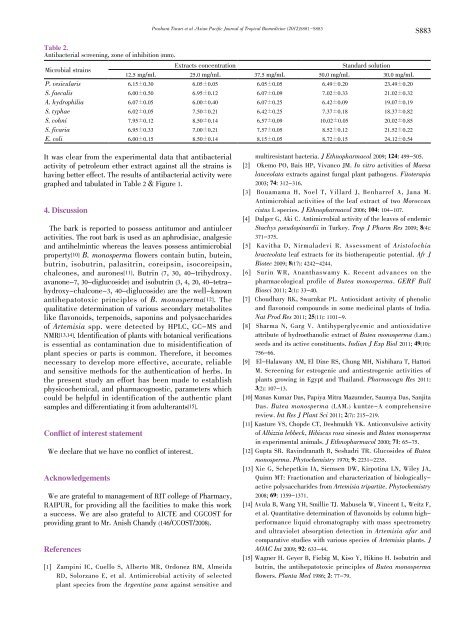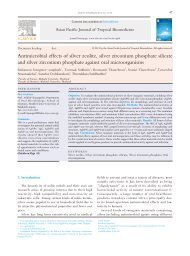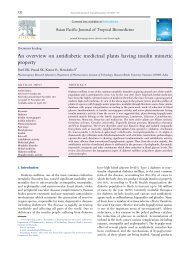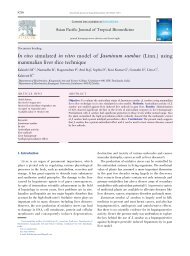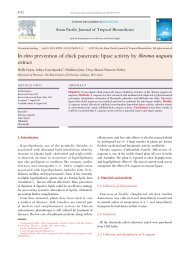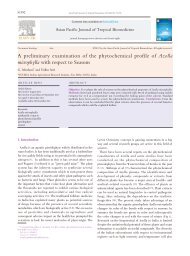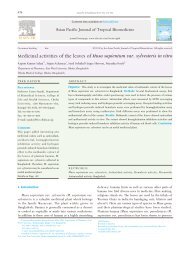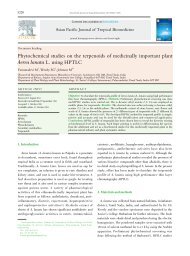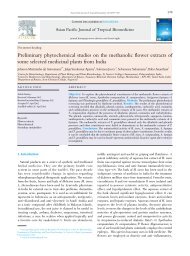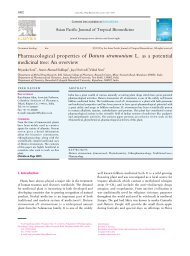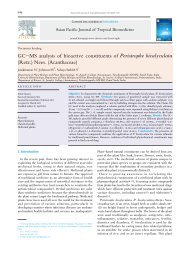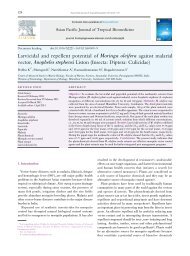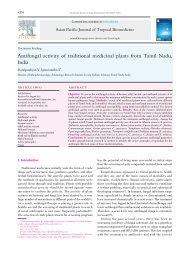Antibacterial activity and physicochemical evaluation of ... - Apjtb.com
Antibacterial activity and physicochemical evaluation of ... - Apjtb.com
Antibacterial activity and physicochemical evaluation of ... - Apjtb.com
Create successful ePaper yourself
Turn your PDF publications into a flip-book with our unique Google optimized e-Paper software.
It was clear from the experimental data that antibacterial<br />
<strong>activity</strong> <strong>of</strong> petroleum ether extract against all the strains is<br />
having better effect. The results <strong>of</strong> antibacterial <strong>activity</strong> were<br />
graphed <strong>and</strong> tabulated in Table 2 & Figure 1.<br />
4. Discussion<br />
The bark is reported to possess antitumor <strong>and</strong> antiulcer<br />
activities. The root bark is used as an aphrodisiac, analgesic<br />
<strong>and</strong> antihelmintic whereas the leaves possess antimicrobial<br />
property[10] B. monosperma flowers contain butin, butein,<br />
butrin, isobutrin, palasitrin, coreipsin, isocoreipsin,<br />
chalcones, <strong>and</strong> aurones[11]. Butrin (7, 30, 40-trihydroxy.<br />
avanone-7, 30-diglucoside) <strong>and</strong> isobutrin (3, 4, 20, 40-tetrahydroxy-chalcone-3,<br />
40-diglucoside) are the well-known<br />
antihepatotoxic principles <strong>of</strong> B. monosperma[12]. The<br />
qualitative determination <strong>of</strong> various secondary metabolites<br />
like flavonoids, terpenoids, saponins <strong>and</strong> polysaccharides<br />
<strong>of</strong> Artemisia spp. were detected by HPLC, GC-MS <strong>and</strong><br />
NMR[13,14]. Identification <strong>of</strong> plants with botanical verifications<br />
is essential as contamination due to misidentification <strong>of</strong><br />
plant species or parts is <strong>com</strong>mon. Therefore, it be<strong>com</strong>es<br />
necessary to develop more effective, accurate, reliable<br />
<strong>and</strong> sensitive methods for the authentication <strong>of</strong> herbs. In<br />
the present study an effort has been made to establish<br />
<strong>physicochemical</strong>, <strong>and</strong> pharmacognostic, parameters which<br />
could be helpful in identification <strong>of</strong> the authentic plant<br />
samples <strong>and</strong> differentiating it from adulterants[15].<br />
Conflict <strong>of</strong> interest statement<br />
We declare that we have no conflict <strong>of</strong> interest.<br />
Acknowledgements<br />
We are grateful to management <strong>of</strong> RIT college <strong>of</strong> Pharmacy,<br />
RAIPUR, for providing all the facilities to make this work<br />
a success. We are also grateful to AICTE <strong>and</strong> CGCOST for<br />
providing grant to Mr. Anish Ch<strong>and</strong>y (146/CCOST/2008).<br />
References<br />
[1] Zampini IC, Cuello S, Alberto MR, Ordonez RM, Almeida<br />
RD, Solorzano E, et al. Antimicrobial <strong>activity</strong> <strong>of</strong> selected<br />
plant species from the Argentine puna against sensitive <strong>and</strong><br />
Prashant Tiwari et al ./Asian Pacific Journal <strong>of</strong> Tropical Biomedicine (2012)S881-S883 S883<br />
Table 2.<br />
<strong>Antibacterial</strong> screening, zone <strong>of</strong> inhibition (mm).<br />
Microbial strains<br />
12.5 mg/mL<br />
Extracts concentration<br />
25.0 mg/mL 37.5 mg/mL<br />
St<strong>and</strong>ard solution<br />
50.0 mg/mL 30.0 mg/mL<br />
P. vesicularis 6.15暲0.30 6.05暲0.05 6.05暲0.05 6.49暲0.20 23.49暲0.20<br />
S. faecalis 6.00暲0.50 6.95暲0.12 6.07暲0.09 7.02暲0.33 21.02暲0.32<br />
A. hydrophilia 6.07暲0.05 6.00暲0.40 6.07暲0.25 6.42暲0.09 19.07暲0.19<br />
S. typhae 6.02暲0.05 7.50暲0.21 6.42暲0.25 7.37暲0.18 18.37暲0.82<br />
S. cohni 7.95暲0.12 8.50暲0.14 6.57暲0.09 10.02暲0.05 20.02暲0.85<br />
S. ficaria 6.95暲0.33 7.00暲0.21 7.57暲0.05 8.52暲0.12 21.52暲0.22<br />
E. coli 6.00暲0.15 8.50暲0.14 8.15暲0.05 8.72暲0.15 24.12暲0.54<br />
multiresistant bacteria. J Ethnopharmacol 2009; 124: 499-505.<br />
[2] Okemo PO, Bais HP, Vivanco JM. In vitro activities <strong>of</strong> Maesa<br />
lanceolata extracts against fungal plant pathogens. Fitoterapia<br />
2003; 74: 312-316.<br />
[3] Bouamama H, Noel T, Villard J, Benharref A, Jana M.<br />
Antimicrobial activities <strong>of</strong> the leaf extract <strong>of</strong> two Moroccan<br />
cistus L species. J Ethnopharmacol 2006; 104: 104-107.<br />
[4] Dulger G, Aki C. Antimicrobial <strong>activity</strong> <strong>of</strong> the leaves <strong>of</strong> endemic<br />
Stachys pseudopinardii in Turkey. Trop J Pharm Res 2009; 8(4):<br />
371-375.<br />
[5] Kavitha D, Nirmaladevi R. Assessment <strong>of</strong> Aristolochia<br />
bracteolata leaf extracts for its biotherapeutic potential. Afr J<br />
Biotec 2009; 8(17): 4242-4244.<br />
[6] Surin WR, Ananthaswamy K. Recent advances on the<br />
pharmacological pr<strong>of</strong>ile <strong>of</strong> Butea monosperma. GERF Bull<br />
Biosci 2011; 2(1): 33-40.<br />
[7] Choudhary RK, Swarnkar PL. Antioxidant <strong>activity</strong> <strong>of</strong> phenolic<br />
<strong>and</strong> flavonoid <strong>com</strong>pounds in some medicinal plants <strong>of</strong> India.<br />
Nat Prod Res 2011; 25(11): 1101-9.<br />
[8] Sharma N, Garg V. Antihyperglycemic <strong>and</strong> antioxidative<br />
attribute <strong>of</strong> hydroethanolic extract <strong>of</strong> Butea monosperma (Lam.)<br />
seeds <strong>and</strong> its active constituents. Indian J Exp Biol 2011; 49(10):<br />
756-66.<br />
[9] El-Halawany AM, El Dine RS, Chung MH, Nishihara T, Hattori<br />
M. Screening for estrogenic <strong>and</strong> antiestrogenic activities <strong>of</strong><br />
plants growing in Egypt <strong>and</strong> Thail<strong>and</strong>. Pharmacogn Res 2011:<br />
3(2): 107-13.<br />
[10] Manas Kumar Das, Papiya Mitra Mazumder, Saumya Das, Sanjita<br />
Das. Butea monosperma (LAM.) kuntze-A <strong>com</strong>prehensive<br />
review. Int Res J Plant Sci 2011; 2(7): 215-219.<br />
[11] Kasture VS, Chopde CT, Deshmukh VK. Anticonvulsive <strong>activity</strong><br />
<strong>of</strong> Albizzia lebbeck, Hibiscus rosa sinesis <strong>and</strong> Butea monosperma<br />
in experimental animals. J Ethnopharmacol 2000; 71: 65-75.<br />
[12] Gupta SR. Ravindranath B, Seshadri TR. Glucosides <strong>of</strong> Butea<br />
monosperma. Phytochemistry 1970; 9: 2231-2235.<br />
[13] Xie G, Schepetkin IA, Siemsen DW, Kirpotina LN, Wiley JA,<br />
Quinn MT: Fractionation <strong>and</strong> characterization <strong>of</strong> biologicallyactive<br />
polysaccharides from Artemisia tripartite. Phytochemistry<br />
2008; 69: 1359-1371.<br />
[14] Avula B, Wang YH, Smillie TJ. Mabusela W, Vincent L, Weitz F,<br />
et al. Quantitative determination <strong>of</strong> flavonoids by column highperformance<br />
liquid chromatography with mass spectrometry<br />
<strong>and</strong> ultraviolet absorption detection in Artemisia afar <strong>and</strong><br />
<strong>com</strong>parative studies with various species <strong>of</strong> Artemisia plants. J<br />
AOAC Int 2009; 92: 633-44.<br />
[15] Wagner H. Geyer B, Fiebig M, Kiso Y, Hikino H. Isobutrin <strong>and</strong><br />
butrin, the antihepatotoxic principles <strong>of</strong> Butea monosperma<br />
flowers. Planta Med 1986; 2: 77-79.


